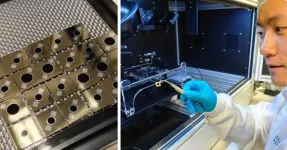(Press-News.org) Early life "luck" plays a pivotal role in shaping individuality and success, particularly for males, according to a new study in mice. In male animals, competitive social dynamics amplified small initial differences into lifelong disparities in fitness. The findings highlight parallels between biological competition and societal inequalities and they demonstrate how chance events can drive divergent outcomes even among genetically identical individuals. Contingency (colloquially, “luck”) refers to the role of chance in shaping outcomes. It is a critical factor in both biological and social sciences, particularly during early life, when pivotal events can set individuals on diverging trajectories. This is especially pronounced in social animals, where interactions within groups amplify the impact of early contingent events. This often creates self-reinforcing disparities in access to resources and success, akin to the "Matthew effect" discussed in social sciences in which those who achieve early success tend to achieve ever greater success in the future. To date, studying the role of contingency in life outcomes has been challenging due to the difficulty of experimentally isolating and testing the effects of early life circumstances under controlled conditions. Matthew Zipple and colleagues compared the developmental trajectories of genetically identical, free-living mice to better understand how microenvironmental differences during development interact with competitive social processes to shape individuality and behavior over time. Zipple et al. found that competition among male mice amplifies minor early life differences, laying the foundation for divergent life paths that affect adult success in areas such as resource access, body condition, and reproduction. In contrast, females – who do not compete for resources – did not show this pattern of contingency amplification. These findings suggest that competitive social dynamics play a critical role in the earlier and more pronounced development of individuality in males compared to females. “Our results add to sociological and biological literature that underscores the potential importance of unpredictable, uncontrollable experiences in generating differences in outcomes even when differences in underlying quality (or “talent”) are small or nonexistent,” write Zipple et al.
END
Early life “luck” among competitive male mice leads to competitive advantage overall
Summary author: Walter Beckwith
2025-01-02
ELSE PRESS RELEASES FROM THIS DATE:
A closer look at the role of rare germline structural variants in pediatric solid tumors
2025-01-02
Largescale changes in the genome inherited from parents are significant risk factors for pediatric solid tumors, such as Ewing sarcoma, neuroblastoma, and osteosarcoma, according to a new study. The findings, which highlight the role of germline structural variants (SVs) in early genome instability, provide new insights into the genetic underpinnings of pediatric cancers and open doors for improved diagnostic and treatment strategies. Unlike adult cancers, which often result from environmental factors or DNA damage built up over time, ...
Genetics of alternating sexes in walnuts
2025-01-02
The genetics behind the alternating sexes of walnut trees has been revealed by biologists at the University of California, Davis. The research, published Jan. 3 in Science, reveals a mechanism that has been stable in walnuts and their ancestors going back 40 million years — and which has some parallels to sex determination in humans and other animals.
Flowering plants have many ways to avoid pollinating themselves. Some do this by structuring flowers to make self-pollination difficult; some species have separate “male” and “female” plants. ...
Building better infrared sensors
2025-01-02
Detecting infrared light is critical in an enormous range of technologies, from remote controls to autofocus systems to self-driving cars and virtual reality headsets. That means there would be major benefits from improving the efficiency of infrared sensors, such as photodiodes.
Researchers at Aalto University have developed a new type of infrared photodiode that is 35% more responsive at 1.55 µm, the key wavelength for telecommunications, compared to other germanium-based components. Importantly, this new device can be manufactured using current production techniques, making it highly practical for adoption.
‘It ...
Increased wildfire activity may be a feature of past periods of abrupt climate change, study finds
2025-01-02
CORVALLIS, Ore. – A new study investigating ancient methane trapped in Antarctic ice suggests that global increases in wildfire activity likely occurred during periods of abrupt climate change throughout the last Ice Age.
The study, just published in the journal Nature, reveals increased wildfire activity as a potential feature of these periods of abrupt climate change, which also saw significant shifts in tropical rainfall patterns and temperature fluctuations around the world.
“This study showed that the planet experienced these short, ...
Dogs trained to sniff out spotted lanternflies could help reduce spread
2025-01-02
Media note: Video of the Labrador retriever, Dia, in action is available for download, along with photos of the dogs and egg masses, here.
ITHACA, N.Y. - Growers and conservationists have a new weapon to detect invasive spotted lanternflies early and limit their spread: dogs trained to sniff out egg masses that overwinter in vineyards and forests.
A Cornell University study found that trained dogs – a Labrador retriever and a Belgian Malinois – were better than humans at detecting egg masses in forested areas near vineyards, while people spotted them better than the dogs in vineyards.
The spotted lanternfly, which was first ...
New resource available to help scientists better classify cancer subtypes
2025-01-02
GRAND RAPIDS, Mich. (Jan. 2, 2025) — A multi-institutional team of scientists has developed a free, publicly accessible resource to aid in classification of patient tumor samples based on distinct molecular features identified by The Cancer Genome Atlas (TCGA) Network.
The resource comprises classifier models that can accelerate the design of cancer subtype-specific test kits for use in clinical trials and cancer diagnosis. This is an important advance because tumors belonging to different subtypes may vary in their response to cancer therapies.
The resource is the first of its kind to bridge the gap between TCGA’s immense data library ...
What happens when some cells are more like Dad than Mom
2025-01-02
NEW YORK, NY--New work by Columbia researchers has turned a textbook principle of genetics on its head and revealed why some people who carry disease-causing genes experience no symptoms.
Every biology student learns that each cell in our body (except sperm and eggs) contains two copies of each gene, one from each parent, and each copy plays an equal part in the cell.
The new study shows that some cells are often biased when it comes to some genes and inactivate one parent’s copy. The phenomenon was discovered about a decade ago, but ...
CAR-T cells hold memories of past encounters
2025-01-02
AURORA, Colo. (Jan. 2, 2025) - Researchers at the University of Colorado Anschutz Medical Campus have discovered that some CAR-T cells engineered to fight cancer and other conditions carry the memory of past encounters with bacteria, viruses and other antigens within them, a finding that may allow scientists to manufacture the cells in more precise and targeted ways.
The study, published today in the journal Nature Immunology, focused on chimeric antigen receptor (CAR)-T cells, an effective therapy against ...
Quantity over quality? Different bees are attracted to different floral traits
2025-01-02
UNIVERSITY PARK, Pa. — When it comes to deciding where they’re going to get their next meal, different species of bees may be attracted to different flower traits, according to a study led by researchers at Penn State and published in PNAS Nexus.
The study focused on two species of solitary bees: the horned-face bee, which helps pollinate crops like apples and blueberries, and the alfalfa leafcutting bee, which pollinates alfalfa.
The researchers found that the horned-face bees tended to prefer plants with a large number of flowers — for them, quantity was most important. ...
Cancer-preventing topical immunotherapy trains the immune system to fight precancers
2025-01-02
A new study by investigators from Mass General Brigham uncovers how a novel immunotherapy prevents squamous cell carcinoma, with benefits lasting five years after treatment. This therapy is the first to activate specific components of the adaptive immune system, particularly CD4+ T helper cells, which are not known to be involved in traditional cancer treatments. This work highlights the potential for similar immunotherapies to prevent other cancers throughout the body. Results are published in the Journal of Clinical Investigation.
“One of the unique challenges with squamous cell carcinoma is that individuals who develop it are at an increased risk of developing multiple new ...
LAST 30 PRESS RELEASES:
SwRI upgrades nuclear magnetic resonance laboratory for pharmaceutical R&D
House sparrows in northern Norway can help us save other endangered animals
Crohn's & Colitis Foundation survey reveals more than 1/3 of young adults with IBD face step therapy insurance barriers
Tethered UAV autonomous knotting on environmental structures for transport
Decentralized social media platforms unlock authentic consumer feedback
American Pediatric Society announces Vanderbilt University School of Medicine as host institution for APS Howland Visiting Professor Program
Scientists discover first method to safely back up quantum information
A role for orange pigments in birds and human redheads
Pathways to net-zero greenhouse gas emissions for Southeast Asia
A JBNU–KIMS collaborative study on a cost-effective alloy matches superalloys for power plants and energy infrastructure
New study overturns long-held model of how plants coordinate immune responses.
New AI model predicts disease risk while you sleep
Scientists discover molecular ‘reshuffle’ and crack an 80-year-old conundrum
How stressors during pregnancy impact the developing fetal brain
Electrons lag behind the nucleus
From fungi to brain cells: one scientist's winding path reveals how epigenomics shapes neural destiny
Schizophrenia and osteoporosis share 195 genetic loci, highlighting unexpected biological bridges between brain and bone
Schizophrenia-linked genetic variant renders key brain receptor completely unresponsive to both natural and therapeutic compounds
Innovative review reveals overlooked complexity in cellular energy sensor's dual roles in Alzheimer's disease
Autism research reframed: Why heterogeneity is the data, not the noise
Brazil's genetic treasure trove: supercentenarians reveal secrets of extreme human longevity
The (metabolic) cost of life
CFRI special issue call for papers: New Frontiers in Sustainable Finance
HKU Engineering scholar demonstrates the smallest all-printed infrared photodetectors to date
Precision empowerment for brain "eavesdropping": CAS team develops triple-electrode integrated functional electrode for simultaneous monitoring of neural signals and chemical transmitters during sleep
Single-capillary endothelial dysfunction resolved by optoacoustic mesoscopy
HKU three research projects named among ‘Top 10 Innovation & Technology News in Hong Kong 2025’ showcasing excellence in research and technology transfer
NLRSeek: A reannotation-based pipeline for mining missing NLR genes in sequenced genomes
A strand and whole genome duplication–aware collinear gene identification tool
Light storage in light cages: A revolutionary approach to on-chip quantum memories
[Press-News.org] Early life “luck” among competitive male mice leads to competitive advantage overallSummary author: Walter Beckwith


